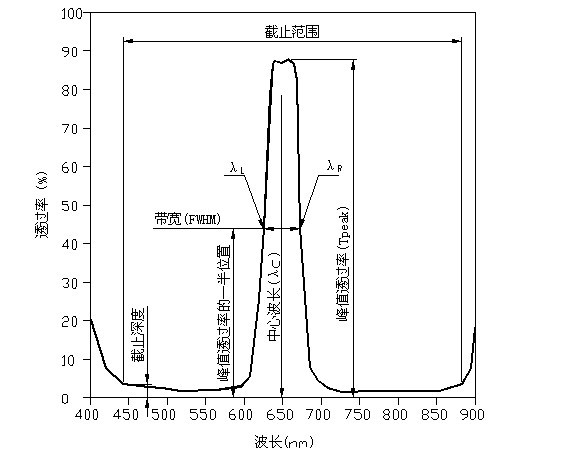What is the relationship between the central wavelength and bandwidth of the filter?
The connection of the bandwidth of the filter is often used in bandpass filters (divided into narrowband and broadband) to describe the connection between the center wavelength and the bandwidth FWHM. Let's first understand the definitions of the two.
What is the relationship between the center wavelength and bandwidth of the filter

(The figure shows the parameter diagram of the bandpass filter, (λL-λR) is the bandwidth)
Bandwidth (FWHM)
Bandwidth, also called half-maximum full width, half-width, half-peak width (not half-bandwidth), literally means the total width at half the position of the peak transmittance of the optical passband. In filters, especially narrowband filters, the larger the bandwidth value, the wider the coverage band range allowed by the filter; on the contrary, the smaller the bandwidth, the smaller the wavelength selection range of the filter, and the more selective it is. In the application of some precision detection instruments, the smaller the wavelength selection, the higher the accuracy.
Center wavelength (CWL)
The center wavelength is often used in the definition of bandpass filters as the midpoint wavelength of the bandwidth within the passband. It can also be used as a wavelength corresponding to the maximum transmittance of the filter, or as a reference for the peak wavelength. In practical applications, such as UV-visible spectrophotometers, the selection of the center wavelength can accurately measure the spectral characteristics of a specific wavelength. For example, in fluorescence microscopy, the center wavelength of the excitation filter determines the wavelength of the excitation light, which in turn affects the excitation efficiency of the fluorescent dye.
Relationship between center wavelength and bandwidth
Jointly determine the spectral characteristics: The center wavelength and bandwidth jointly determine the spectral transmittance characteristics of the filter. The center wavelength determines the main action wavelength of the filter, while the bandwidth defines the spectral width allowed to be transmitted around this wavelength, that is, the accuracy.
Influence on the use effect: When selecting a filter, it is necessary to determine the appropriate center wavelength and half-bandwidth according to the specific application scenario and requirements. For example, in applications that require high spectral selectivity, a filter with an accurate center wavelength and a narrow bandwidth should be selected; in applications that require a wider spectral range, a filter with a larger half-bandwidth can be selected.
Mutual constraints: From the perspective of manufacturing technology, there is a certain constraint relationship between the center wavelength and bandwidth of the filter. Generally speaking, the smaller the bandwidth, the more difficult the filter is to process and the higher the cost. Therefore, when designing and manufacturing filters, it is necessary to balance and optimize between the center wavelength and half bandwidth.
In summary, the center wavelength and half bandwidth of the filter are two closely related parameters, which together determine the spectral characteristics and use effect of the filter. When selecting a filter, it is necessary to comprehensively consider the influence of these two parameters according to specific application requirements and scenarios. Of course, these two parameters are only two reference parameters for the filter, and more practical application conditions are also needed to determine the indicators of the filter.